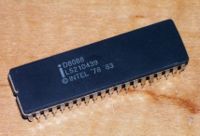X86
x86 is the instruction set architecture (ISA) for the Intel 8086 and 8088 chips, 16-bit microprocessors first produced in 1978. [1] The cheaper 8088 chip (which contained an 8-bit multiplexed bus, as opposed to a full 16-bit bus in the 8086) was used in the very first incarnation of an IBM compatible PC introduced by IBM in 1983. The term "x86" is also used colloquially to describe the entire line of processors that are based on this chipset, e.g. the 286, 386, 486, etc.
The x86 instruction set achieved historic status due to a remarkable decision, made jointly by the designers of the original IBM compatible PC. They decided to maintain backward compatibility in both software and hardware, and to maintain it indefinitely, Thus, all subsequent "Intel" processor chips in the 86-styled family would always execute the original x86 instructions, and all subsequent Microsoft operating systems would execute programs which ran on the original IBM compatible PC. This agreement has stayed in effect from 1983 to the present time, a remarkable collaboration involving many different companies who came to manufacture hardware associated with IBM compatible PCs, including x86-compatible processors from non-Intel companies such as AMD.
This decision to maintain backward compatibility of hardware and software laid the groundwork for the subsequent success of the x86 family of microprocessors, and the IBM compatible PCs which contain them.
Related Topics
References
- ↑ "Intel Museum: The Microprocessor Hall of Fame". Retrieved on 2007-04-09.
